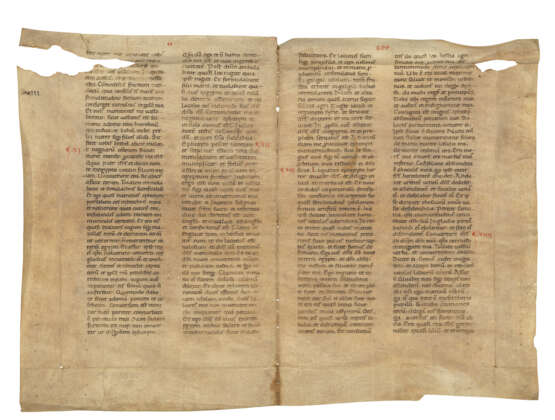ID 869441
Lot 45 | Bifolium from a large Bible
Estimate value
£ 1 000 – 1 500
A huge bifolium from a Bible in Latin, decorated manuscript on vellum [Italy, mid(?) 12th century].
From an extremely large and legible Bible, probably used for the daily readings in the choir or refectory of a monastery.
Each leaf c.530×375mm. 2 columns of 44 lines, blind ruled, the pricking preserved, written in a fine late Caroline minuscule with one rubric and incipit in rustic capitals, running headings in red, the central bifolium of a quire with continuous text comprising Hosea 9:4 to the end of the book, followed by four prologues to Joel (‘[intra]bit in domum domini […] Explicit Liber Osee prophetę. Incipit prologus in libro Ioel. Iohel filius fatuel […] Item alium. [I]ohel qui interprætatur dominus deus sive incipiens deo […] Item alium. Iohel de tribu Ruben […] Item alium. Sanctus Iohel apud Hebreos post Oseę ponitur […] in scripturis sanctis’; the second prologue is apparently unrecorded or at least unknown to Stegmüller, the others are Stegmüller, Repertorium Biblicum, nos. 510, 509, 511), with pre-modern marginal chapter numbers VII–VIII in black at Hosea 9:6 and 10:13, and 13th-century marginal numbers in red X–XIIII at the modern divisions, initials in red, the first Joel initial with a fine reserved design and foliate ornament (recovered from use as a book cover, with consequent folds, holes with small losses of text, etc., but overall very imposing)
Provenance:
(1) Erik von Scherling (d. 1956), Rotulus, V (Leiden, 1949), no 2061.
(2) Colker MS 114, acquired in 1966 from Maggs.
This bifolium belongs to a genre of Bibles termed ‘Giant’ by Walter Cahn (Romanesque Bible Illumination, Ithaca, NY, 1982) and Larry Ayres (‘The Italian Giant Bibles: Aspects of their Touronian Ancestry and Early History’, in R. Gameson ed., The Early Medieval Bible: Its Production, Decoration and Use, Cambridge, 1994, pp. 125–54), and ‘Atlantic’ by E.B. Garrison (Studies in the History of Medieval Italian Painting, 4 vols., Florence, 1953–62). The latter term was used in the title of detailed study and exhibition dedicated to such Bibles: Le Bibbie atlantiche: il libro delle Scritture tra monumentalità e rappresentazione, ed. by Marilena Maniaci and Giulia Orofino (Montecassino Abbey, 2000). Although the genre originated in the mid-11th century and the earliest examples are from Germanic areas, they became particularly characteristic of 12th-century Italian book production, especially in Tuscany and the Umbro-Roman region.
| Genre: | Religious genre |
|---|---|
| Place of origin: | Italy |
| Auction house category: | Medieval & renaissance manuscripts |
| Genre: | Religious genre |
|---|---|
| Place of origin: | Italy |
| Auction house category: | Medieval & renaissance manuscripts |
| Address of auction |
CHRISTIE'S 8 King Street, St. James's SW1Y 6QT London United Kingdom | |
|---|---|---|
| Preview |
| |
| Phone | +44 (0)20 7839 9060 | |
| Buyer Premium | see on Website | |
| Conditions of purchase | Conditions of purchase |





